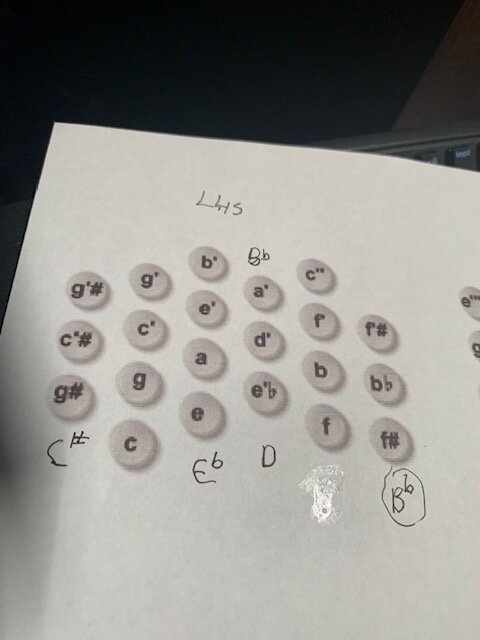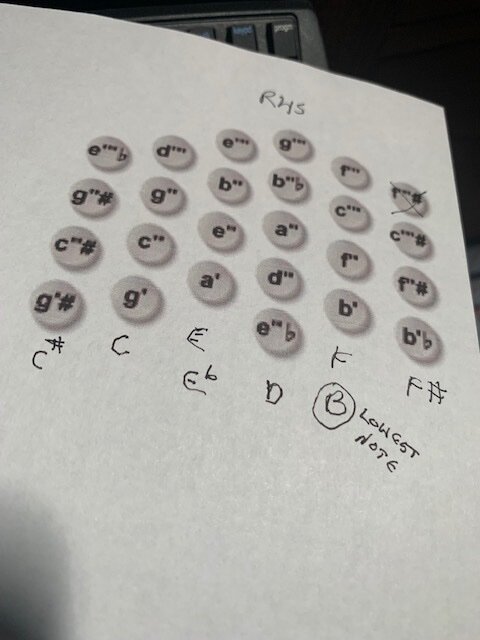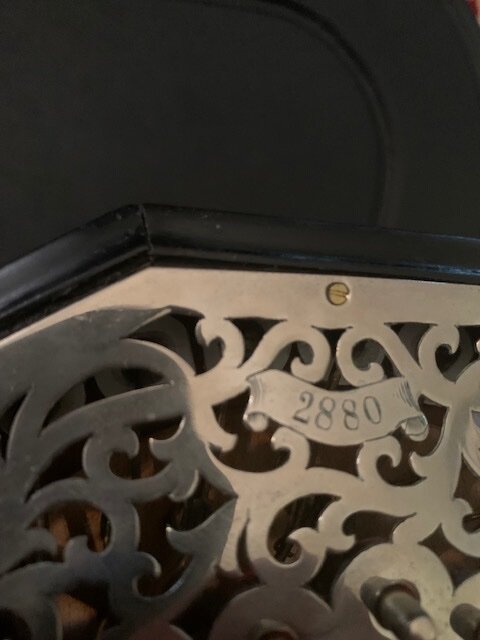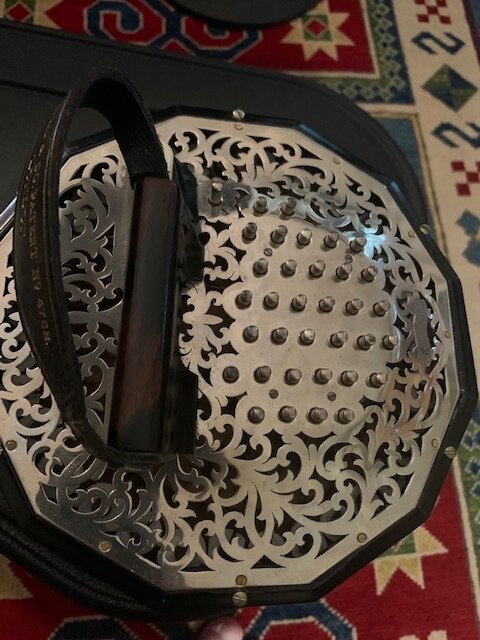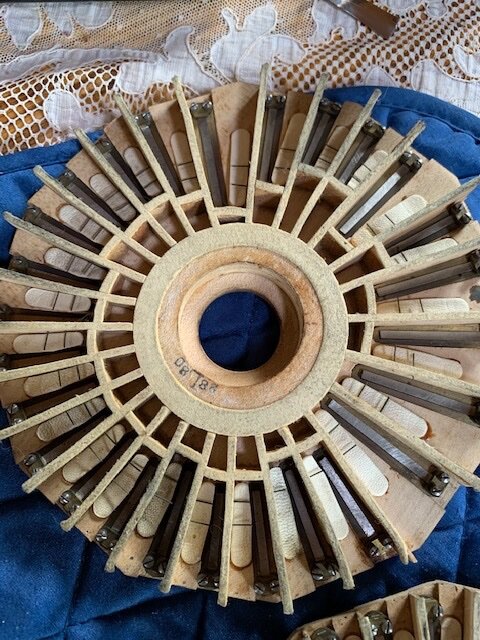
robert stewart
Members-
Posts
98 -
Joined
-
Last visited
Everything posted by robert stewart
-
Edeophonic Confusion. Following the information thus far: is the Chris Algar owned unique Edeophone (28821) in Britain the same instrument as the Edeophone shown in the photo by Matthew Heumann, where he seems to say that it is his instrument (in the USA)? Perhaps Matthew could clear this up? As of yesterday the instrument was still listed for sale on the Barleycorn website...as it has been for a number of years. best wishes, Robert
-
Has anyone looked at Barleycorn Concertinas (English Concertinas, for sale), where there is what seems to be an identical Lachenal Tenor-Treble Edeophone with the graceful fretwork? This is still described as the only known one of such design. Am I missing some info, or are there now two such early Edeophones known? (I love my extended Edeophone, from the early 20th). Robert Stewart
-
Comically Long Duet Concertina
robert stewart replied to Squeezebox Of Delights's topic in General Concertina Discussion
I noticed the reference to "Vauderville" (sic). With an "r". It seems that the vendor thinks VaudeRville was a place? or a specific theater? Of course Vaudeville was the widely used American name for what in Britain was called Music Hall entertainment...and this would be the obvious home for an exotic probably comedic instrument . We might guess that the vendor should look carefully inside both ends, and take photos. What if there is a signature in there...as there often was? Robert -
Effect of temperature on tuning
robert stewart replied to SteveS's topic in Instrument Construction & Repair
I have been playing acoustic instruments (professionally), including English concertina, since the late 1960s (in Britain, then in the USA). Britain had a colder and wetter ambience for many years until central heating or similar systems became widespread. As we probably all know, the Victorian/Edwardian eras were distinctly cold, wet, and smokey when compared to the present. Cities especially were horribly polluted by smoke, mainly from coal fires (think of London, or Bath, or Glasgow etc). Thus the great concertinas of the past were made and played mostly in colder damper dirtier environments than those we store and play instruments in today. In the US, of course, much of the struggle is to keep high quality instruments (of all sorts) humidified, especially in the stunning aridity of the East Coast and the Mid West. There seem to be several conclusions we can consider, but one stands out: musicians were less concerned about "accurate" pitch and pitch variations. There were no digital tools for measuring frequencies. Tuning forks tended to be the standard. This does not mean that musicians were slipshod and careless, but that they played, together or solo, with more concern for music than for tiny pitch variations. Many examples of early recordings show quite different tonal and pitch textures to contemporary modern recordings, and the difference is often thought of as being due to the old recording and pressing (discs, cylinders) methods. But, at least in equal part, they are due to the way ensembles and solos actually sounded. In the Middle East and Mediterranean , or in India (and many other countries) musicians playing together spend time collectively adjusting the modes/scales on their instruments before they actually play anything. But of course, we cannot do that with the concertina. Robert Stewart (currently playing a beautiful extended scale Edeophone from the early 20th century. Which has several "flat"notes, of course. Or are the others sharp?) -
Yesterdays Wall Street Journal
robert stewart replied to Devils' Dream's topic in Concertina Videos & Music
This cartoon is a variant of a popular banjo player cartoon, wherein we see the couple in bed, and he is playing the banjo, while she looks at him. He says "What's the matter darling...can't you sleep either?" (Do members of this list read the Wall Street Journal? Are the prices of concertinas that high?) RJ -
Perhaps this has been commented upon before (?) but in one of the famous Goya paintings of witches and their goat god, a witch is playing a concertina. https://en.wikipedia.org/wiki/Witches'_Sabbath_(Goya,_1798)#/media/File:Francisco_de_Goya_y_Lucientes_-_Witches'_Sabbath_(The_Great_He-Goat).jpg Look for the figure on the far right, with what looks like a typical Continental style concertina with the two-part bellows. Is 1798 early for a concertina of any kind ? So maybe the Salvation Army knew something about the concertina that needed redemption. Robert
-
It certainly looks like the famous "golden" Aeola: Alf Edwards had the bellows gilded, and I think this instrument matches various photos of same. The golden treatment gradually wore off over the years. As featured elsewhere, Alf Edwards had several sets of reed pans that he could exchange in the concertina according to musical need. best wishes, Robert
-
https://www.ebay.com/itm/354531095961?hash=item528bb33599:g:S6cAAOSwk5Jjyi4b&amdata=enc%3AAQAHAAAAsGitZqxeYFeOdujEM%2FaxjikfMMzoNM9i6hDG%2BSQpg%2FKc2LHzRWx3n9e9Le9daY5%2B4EFFn%2FlUDO8YnbgZ54p2la6ebVo7b%2FGlatVgZOGxjj1Ncr19kXwshZOEJOtoEiczJbgNHiYGNT8kaaIsd2ArACd7f7N6Ih2TFq3LDrbUBiFlLW1MZwspIO4GiZ8Bicl30srwTOuI8Ezy2xkWe2bMm%2FkSoYFzUxQ%2F%2Bo%2B6eYTm05CV|tkp%3ABk9SR5rtkaC7YQ
-
english concertina sea shanties ?
robert stewart replied to amberlayli's topic in General Concertina Discussion
Richard is 100% right. It is strange, but so well established now, that concertinas are associated with sea shanties. I knew the late Stan Hugill slightly, in Britain. When he sang he was really LOUD. He learned some of his shanties before the mast, as an old time sailor. If the shanty is a work song, at sea, on deck, the sailors have to be able to hear it above the howling winds, flapping sales, roaring seas. The shanty is a work-song, not a relaxing entertainment. So our beloved concertina does not suffice (!). And no one would be playing a concertina while others worked. But the romantic association of concertina and sailing ships is very satisfying for song accompaniment on shore, so why not? Providing we do not confuse history with artistry . Robert -
Learning by ear vs learning from notation
robert stewart replied to Parker135's topic in Teaching and Learning
The traditional way to learn tunes in Ireland, Scotland, the Appalachians, was to learn to sing the tune first. In other words it was in the memory before you worked on the fingering. An older musician would sing the phrases to the younger, who would sing them back until they were correct. The instrument was not touched until the tune was learned.Then the fingering learning. Then the decorations... I would be fairly certain that many people on this list will be able to sing some tunes that they have not (yet) learned to play...so we still benefit from memory for music today. Memory before playing, before reading. Gradually this method, which is classic for an oral tradition, seems to have diminished. Robert -
Some years ago I had a full set of uilleann pipes (in C) made of lignum vitae by Alan Ginsburg. When the set was new there were some shrinkage movements and very fine hairline cracks. Over a few weeks of playing every day, the entire instrument settled down. The hairline cracks disappeared before there were any discussions about repair or replacement, and they never reappeared. This was in a classic wet English climate in Wiltshire, and the pipes were made in a wetter climate in North Wales. The chanter and regulators sounded magnificent, and the whole set had a warm expressive sound. And a distinctive "piney" odor. Lignum Vitae...the Tree of Life. Robert
-
Guitar or Concertina?
robert stewart replied to SIMON GABRIELOW's topic in General Concertina Discussion
Regondi was a virtuoso guitarist. So was Paganini...though he did not play concertina. RJ -
What is your favourite key?
robert stewart replied to SIMON GABRIELOW's topic in General Concertina Discussion
On English Concertina (56 button Edeophone) I always enjoy playing in Bb. I like the sound and the feel of Bb. I am thinking of having my concertina "dropped" a tone, so that the C scale sounds Bb, the D scale sounds C, and so forth. It would be interesting to hear input from the concertina makers, tuners, and experts on this idea (please?). Robert Stewart -
At this time, Wim Wakker is definitely making concertinas. He is currently making a baritone for me, his Parnassus model, which should be ready by January, possibly February. I believe that the workshop there makes sets of instruments on a schedule. I have not had any email problems, and have always received prompt and helpful responses. best wishes, Robert
-
yes it is still available. Several people have shown interest, but no one has committed yet. Do please send me a Private Message if you want to proceed: if you buy, I can make a donation to Concertina.net rather than throw money at Ebay where the Edeophone Duet is currently listed. Where are you located? Best Wishes, Robert.
-
Greetings Steve. What is your experience/opinion with your Parnassus concertina? You can send me a PM if you prefer (if in forum should this be a separate thread?) best wishes, Robert
-
KEYBOARD LAYOUT: I started with the Maccann layout as shown on concertina.com, found where it matched, and added all the lower rows. Note that the F#, uppermost right RHS is not present, but a low F#, lower right RHS is present. This instrument has a loud voice overall, and yet a good dynamic range. The highest note is the top RHS C. the lowest note of all is a (RHS) B which sounds like the horn of the gods. The air button is on the RHS, plus a whistle and a duck quack (helpful for Vivaldi's Four Seasons in vaudeville interpretation). Those three are in a small row additional on the far left, right by the thumb. Not shown in these diagrams n
-
Lachenal Edeophone, Circa 1909 A large 60 button, plus air button, Lachenal Edeophone, MacCann Duet system.The "Rolls Royce" of concertinas. Serial number dates it to circa 1909. Nickel plated raised ends, 9-fold (!) bellows. Old leather case, needs work, has the name of Harry Edson, a vaudeville entertainer. Completely and beautifully restored and tuned to concert pitch by maestro Greg Jowaisas, last year. Steel reeds in brass shoes. Offers over $1950 plus shipping.




